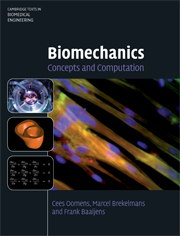Book contents
- Frontmatter
- Contents
- About the cover
- Preface
- 1 Vector calculus
- 2 The concepts of force and moment
- 3 Static equilibrium
- 4 The mechanical behaviour of fibres
- 5 Fibres: time-dependent behaviour
- 6 Analysis of a one-dimensional continuous elastic medium
- 7 Biological materials and continuum mechanics
- 8 Stress in three-dimensional continuous media
- 9 Motion: the time as an extra dimension
- 10 Deformation and rotation, deformation rate and spin
- 11 Local balance of mass, momentum and energy
- 12 Constitutive modelling of solids and fluids
- 13 Solution strategies for solid and fluid mechanics problems
- 14 Solution of the one-dimensional diffusion equation by means of the Finite Element Method
- 15 Solution of the one-dimensional convection-diffusion equation by means of the Finite Element Method
- 16 Solution of the three-dimensional convection-diffusion equation by means of the Finite Element Method
- 17 Shape functions and numerical integration
- 18 Infinitesimal strain elasticity problems
- References
- Index
14 - Solution of the one-dimensional diffusion equation by means of the Finite Element Method
Published online by Cambridge University Press: 05 June 2012
- Frontmatter
- Contents
- About the cover
- Preface
- 1 Vector calculus
- 2 The concepts of force and moment
- 3 Static equilibrium
- 4 The mechanical behaviour of fibres
- 5 Fibres: time-dependent behaviour
- 6 Analysis of a one-dimensional continuous elastic medium
- 7 Biological materials and continuum mechanics
- 8 Stress in three-dimensional continuous media
- 9 Motion: the time as an extra dimension
- 10 Deformation and rotation, deformation rate and spin
- 11 Local balance of mass, momentum and energy
- 12 Constitutive modelling of solids and fluids
- 13 Solution strategies for solid and fluid mechanics problems
- 14 Solution of the one-dimensional diffusion equation by means of the Finite Element Method
- 15 Solution of the one-dimensional convection-diffusion equation by means of the Finite Element Method
- 16 Solution of the three-dimensional convection-diffusion equation by means of the Finite Element Method
- 17 Shape functions and numerical integration
- 18 Infinitesimal strain elasticity problems
- References
- Index
Summary
In the present and following chapters extensive use will be made of a simple finite element code mlfem_nac. This code, including a manual, can be freely downloaded from the website: www.mate.tue.nl/biomechanicsbook.
The code is written in the program environment MATLAB. To be able to use this environment a licence for MATLAB has to be obtained. For information about MATLAB see: www.mathworks.com.
Introduction
It will be clear from the previous chapters that many problems in biomechanics are described by (sets of) partial differential equations and for most problems it is difficult or impossible to derive closed form (analytical) solutions. However, by means of computers, approximate solutions can be determined for a very large range of complex problems, which is one of the reasons why biomechanics as a discipline has grown so fast in the last three decades. These computer-aided solutions are called numerical solutions, as opposed to analytical or closed form solutions of equations. The present and following chapters are devoted to the numerical solution of partial differential equations, for which several methods exist. The most important ones are the Finite Difference Method and the Finite Element Method. The latter is especially suitable for partial differential equations on domains with complicated geometries, material properties and boundary conditions (which is nearly always the case in biomechanics). That is why the next chapters focus on the Finite Element Method. The basic concepts of the method are explained in the present chapter.
- Type
- Chapter
- Information
- BiomechanicsConcepts and Computation, pp. 232 - 263Publisher: Cambridge University PressPrint publication year: 2009

